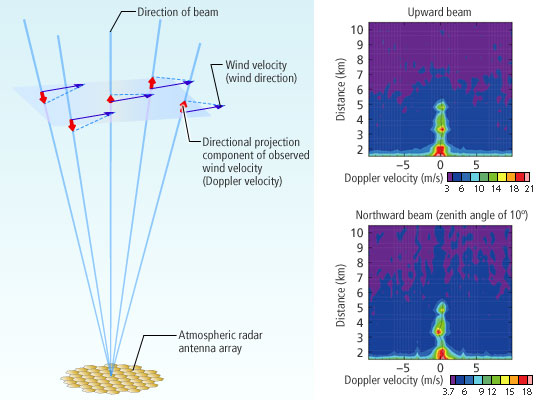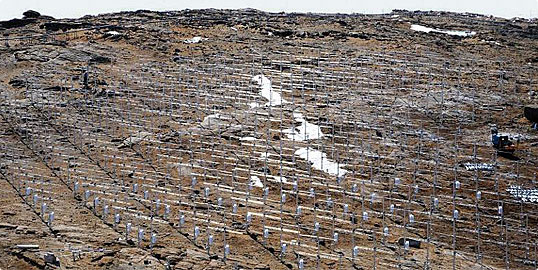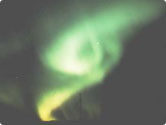Clouds and auroras that shine at night. A project to study these unique polar phenomena using large-scale radar to observe and elucidate the movement of the atmosphere has begun. A radar composed of approximately 1,000 antennas will probe yet another mystery of the natural world.
The thought behind the pansy

The pansy—a member of the violet family—was bred in Scandinavia in the 1800s through cross-fertilization between several species of violet with a view to creating large, vividly colored flowers. Pansies of different colors still provide enjoyment to this day. The flower of the pansy inclines forward in summer, looking for all the world like a person in contemplation. The name "pansy" is said to be derived from the French word "pensée," which means "thought."
For some, the name "Pensées" will probably call to mind the compilation of literary fragments by Blaise Pascal. His aphorism that "Man is but a thinking reed" signifies that man is feeble—like a reed—but differs from other animals in that he can think.
In the pursuit of science, man has long contemplated various phenomena. The Tohoku Earthquake of March 2011 appears to have significantly undermined confidence in some branches of science. The reality is, however, that Japan continues to lead the world in terms of scientific and technological capability.
The PANSY project (Program of the Antarctic Syowa MST/IS Radar—hereafter "PANSY") has now commenced. This is a large-scale scientific project led by Japan to observe the Antarctic winds. Human beings will continue to contemplate and comprehend a new reality. Japan will continue to tread this path.
From the Antarctic clouds that shine at night to an understanding of climate change

Noctilucent clouds. The sun has already set overhead but clouds at a height of around 85 km shine brightly from the light of the westering sun. The way in which noctilucent clouds are formed is not yet properly understood.
©alamy/PPS
To an observer in space, the Earth appears to be wreathed in a thin, veil-like atmosphere. The clouds weave complex patterns. The reason for this is that the atmosphere of the Earth behaves in a complex fashion, which is tied to the rotational movement of the planet. Atmospheric researchers have been observing the currents in the atmosphere from various locations and increasing their understanding of global weather and the global climate. Observation has proceeded at low and medium latitudes using a wide variety of radar types. However, there had hitherto been no progress on observation in the Antarctic—due in part to its inaccessibility. As well as the fact that noise from human activity does not intrude into Antarctica, there are also many unexplained atmospheric phenomena in the continent. "For these reasons we thought that it would be a good idea to set up a large-scale atmospheric radar and carry out observation." says the organizer of the PANSY project, Professor Kaoru Sato of the School of Science at the University of Tokyo.
One phenomenon that is related to human activity is noctilucent clouds. As the name suggests, this is the phenomenon of clouds that shine brightly, while all around is the darkness of night. These are said to be polar mesospheric clouds, which are formed at altitudes in the region of 85 km and which appear to shine with the light of the westering sun—even after sunset. These clouds are formed around aerosols generated by human activity or cinders from meteors, and their existence has a major effect on climate change.
The PANSY radar was constructed at Syowa Station in the Antarctic for the purpose of exploring this phenomenon. There are 1,045 antennas, each weighing a mere 13 kg. "We have made strenuous efforts to alleviate—if only a little—the stresses of working in the harsh environment of Antarctica," says Professor Sato. In December 2010, the 52nd Japanese Antarctic Research Expedition transported the building materials for the radar to the Antarctic and construction commenced. In April 2011, it was announced that the first successful observations had been made.
The PANSY radar—seeing the wind
PANSY is a project for observing atmospheric motions in the Antarctic—in other words, for observing winds. The density of the atmosphere is continually fluctuating, scattering radio waves as a result. Since these fluctuations in the density move around with the flow of the atmosphere (that is, the winds), the radio waves which have been scattered and then return undergo a shift from their original frequency, due to the so-called Doppler effect. It is this shift that is observed. The strong radio waves emitted by the 1,045 antennas of the PANSY radar enable it to observe wind speed as a function of the altitude. Operating at full capacity, it is said to be able to observe various properties of winds (including electron density, electron and ion temperature) that range in altitude from 1 km to 500 km.
For many years atmospheric scientists have used radar in their research. In 1984 a research group from Kyoto University built a 475-antenna radar in Shiga Prefecture, Japan. Then, in 2005, a radar for observing the equatorial atmosphere was set up on the island of Sumatra in Indonesia. In Europe, in the Svalbard Islands in the Arctic, observation of the ionosphere is being carried out. The establishment of PANSY radar in the Antarctic completes a worldwide atmospheric observation network that now stretches all the way from the Antarctic to the Arctic, encompassing the equator, the northern hemisphere, and the middle latitudes. The PANSY radar is an example of world-class achievement by Japan.

Scattering signals from the atmosphere obtained in test observations on March 30, 2011 using the PANSY radar. Vertical profiles of vertical winds are obtained using the upward beams, while vertical profiles of meridional winds are obtained using the northward beams.

The PANSY radar set up in Maigosawa at Syowa Station. Although the location in which the radar has been set up is not flat and has rises and depressions, the phase of the radio waves transmitted from the individual antennas is adjusted so that overall the equipment emits a powerful radar beam.
© National Institute of Polar Research
Many phenomena seen at once

An aurora observed from the Syowa Station in the Antarctic. New discoveries resulting from observation carried out by PANSY are anticipated.
© National Institute of Polar Research
The aurora—a feast of light that must be seen at least once. Capturing such mysterious phenomena is also an important aspect of the PANSY radar's mission.
The aurora is a phenomenon in which electrically charged particles from the Earth's magnetic field cause atoms and molecules to emit light. This phenomenon is often evident in periods of vigorous solar activity. There are also many as-yet unexplained aspects of solar activity, which is observed in many different ways, such as via satellites. Observation of auroras will likely lead to a clearer understanding of the Sun and—by extension—climate change on Earth.
Observations are expected to be conducted of atmospheric gravity waves generated by the strong winds, cyclones, and jet streams that traverse the cold Antarctic continent. It has hitherto been difficult to observe atmospheric gravity waves, as they are small and weak. However, they can propagate for distances of over 100 km and it is now understood that they are essential to the prediction of climate change.
The PANSY radar can simultaneously observe phenomena such as noctilucent clouds, auroras, and atmospheric gravity waves. After 10 years of preparation, the PANSY program has commenced observation—with exciting prospects for the future.
Editorial contributor / Date of article posted
Kaoru Sato, Professor, Graduate School of Science, University of Tokyo / August 2011

